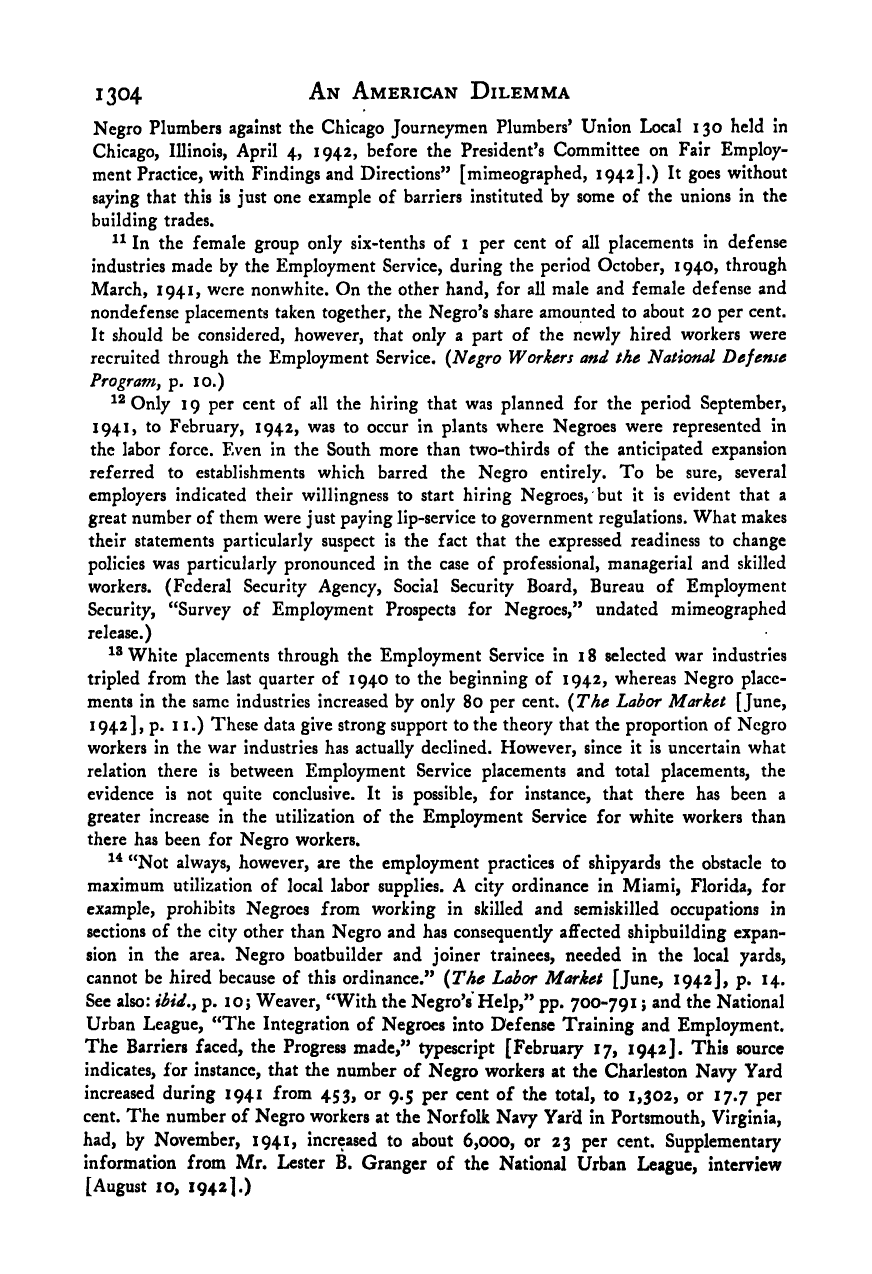Note: Gunnar Myrdal died in 1987, less than 70 years ago. Therefore, this work is protected by copyright, restricting your legal rights to reproduce it. However, you are welcome to view it on screen, as you do now. Read more about copyright.
Full resolution (TIFF) - On this page / på denna sida - Footnotes - Chapter 19

<< prev. page << föreg. sida << >> nästa sida >> next page >>
Below is the raw OCR text
from the above scanned image.
Do you see an error? Proofread the page now!
Här nedan syns maskintolkade texten från faksimilbilden ovan.
Ser du något fel? Korrekturläs sidan nu!
This page has never been proofread. / Denna sida har aldrig korrekturlästs.
1304 An American Dilemma
Negro Plumbers against the Chicago Journeymen Plumbers* Union Local 130 held in
Chicago, Illinois, April 4, 1942, before the President’s Committee on Fair Employ-
ment Practice, with Findings and Directions” [mimeographed, 1942].) It goes without
saying that this is just one example of barriers instituted by some of the unions in the
building trades.
In the female group only six-tenths of i per cent of all placements in defense
industries made by the Employment Service, during the period October, 1940, through
March, 1941, were nonwhite. On the other hand, for all male and female defense and
nondefense placements taken together, the Negro’s share amounted to about 20 per cent.
It should be considered, however, that only a part of the newly hired workers were
recruited through the Employment Service. {Negro Workers and the National Defense
Program^ p. lO.)
Only 1 9 per cent of all the hiring that was planned for the period September,
1941, to February, 1942, was to occur in plants where Negroes were represented in
the labor force. Even in the South more than two-thirds of the anticipated expansion
referred to establishments which barred the Negro entirely. To be sure, several
employers indicated their willingness to start hiring Negroes, but it is evident that a
great number of them were just paying lip-service to government regulations. What makes
their statements particularly suspect is the fact that the expressed readiness to change
policies was particularly pronounced in the case of professional, managerial and skilled
workers. (Federal Security Agency, Social Security Board, Bureau of Employment
Security, “Survey of Employment Prospects for Negroes,” undated mimeographed
release.)
White placements through the Employment Service in 1 8 selected war industries
tripled from the last quarter of 1940 to the beginning of 1942, whereas Negro place-
ments in the same industries increased by only 80 per cent. {The Labor Market [June,
1942], p. II.) These data give strong support to the theory that the proportion of Negro
workers in the war industries has actually declined. However, since it is uncertain what
relation there is between Employment Service placements and total placements, the
evidence is not quite conclusive. It is possible, for instance, that there has been a
greater increase in the utilization of the Employment Service for white workers than
there has been for Negro workers.
“Not always, however, are the employment practices of shipyards the obstacle to
maximum utilization of local labor supplies. A city ordinance in Miami, Florida, for
example, prohibits Negroes from working in skilled and semiskilled occupations in
sections of the city other than Negro and has consequently affected shipbuilding expan-
sion in the area. Negro boatbuilder and joiner trainees, needed in the local yards,
cannot be hired because of this ordinance.” {The Labor Market [June, 1942], p. 14.
See also: ibid.^ p. lO; Weaver, “With the Negro’s Help,” pp. 700-791 ; and the National
Urban League, “The Integration of Negroes into Defense Training and Employment.
The Barriers faced, the Progress made,” typescript [February 17, 1942]. This source
indicates, for instance, that the number of Negro workers at the Charleston Navy Yard
increased during 1941 from 453, or 9,5 per cent of the total, to 1,302, or 17.7 per
cent. The number of Negro workers at the Norfolk Navy Yard in Portsmouth, Virginia,
had, by November, 1941, increased to about 6,000, or 23 per cent. Supplementary
information from Mr. Lester B, Granger of the National Urban League, interview
[August 10, 1942].)
<< prev. page << föreg. sida << >> nästa sida >> next page >>